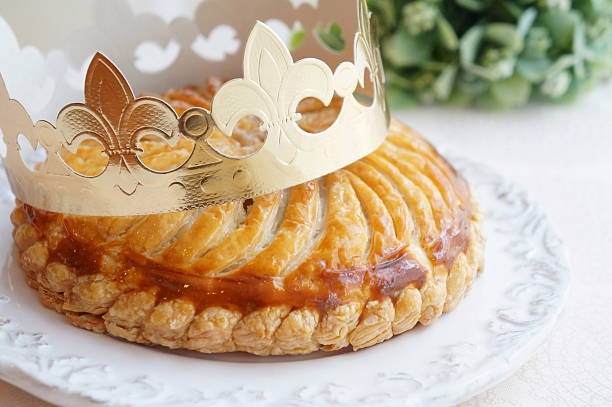Starting around Christmas and running through the Feast of the Epiphany (January 6), the French celebrate with a variety of traditional dishes. One of them is a Galette des Rois or King Cake.

Following tradition, a Galette des Rois is traditionally served as dessert on the Feast of the Epiphany, signifying the conclusion of the 12 days of Christmas and the moment when the Three Kings visited the Baby Jesus.
There is a debate as to whether a Galette des Rois and a pithivier are the same thing or not. Both the Galette des Rois and the pithivier are French pastries, but they differ in terms of their composition, shape, and cultural significance.
- Galette des Rois:
- Composition: The galette des rois is typically made with puff pastry and filled with frangipane, a sweet almond cream. Some variations may use other fillings such as fruit compote or chocolate.
- Shape: The galette des rois is generally round and flat, resembling a large, rustic tart. It is often decorated with a pattern on top, and a small charm or figurine (called a fève) is hidden inside the filling.
- Cultural Significance: The galette des rois is associated with the celebration of Epiphany, which marks the arrival of the three wise men to see the baby Jesus. In France, it is traditionally eaten in January, especially on January 6th (Twelfth Night or Epiphany), and sometimes throughout the entire month.
- Pithivier:
- Composition: The pithivier, on the other hand, is made with puff pastry and is typically filled with almond cream, similar to the galette des rois. However, the filling in a pithivier can vary, and it may include other ingredients such as pastry cream, fruit compote, or chocolate.
- Shape: The pithivier is round and has a distinctive scalloped edge. It is often smaller and more compact than a galette des rois. The top of a pithivier is usually scored with radiating lines that meet at the center.
- Cultural Significance: While the galette des rois has strong ties to the Epiphany celebration, the pithivier is not specifically associated with a particular holiday. It can be enjoyed at various times of the year and is more versatile in terms of fillings.
In summary, while both pastries share some similarities, the galette des rois is more closely linked to the celebration of Epiphany, has a specific shape and decorative tradition, and often includes the hidden fève. The pithivier, on the other hand, is a more versatile pastry that can be enjoyed throughout the year with a wider range of fillings and lacks the strong association with a particular holiday.
This cake features a frangipane layer nestled between two puff pastry layers. Concealed within the frangipane is a fève, which can now range from a bean to an almond, or even a small ring or trinket. Certain bakeries in France have gained recognition for their Galette des Rois, as they provide a variety of fèves, turning them into sought-after collectibles.
Upon cutting the cake, it is customary for the youngest child to determine who gets which piece. The fortunate individual discovering the fève is ceremoniously crowned with a gold crown, adorning the cake and earning the title of king or queen for the day.
Although there are many different ways to make a Galette des Rois, the traditional flavoring is almond. Although this recipe does include instructions on how to make your own puff pastry, you can skip this step and buy a good-quality store-bought puff pastry. Just make sure two sheets are included as you will need one for the base and one for the top.
Note: After cutting the rounds out you will inevitably have left-over puff pastry. Don’t discard it. Instead, sprinkle sugar or cinnamon sugar on the scraps and roll them up and bake them. You can also put a small dollop of jam, chopped chocolate, nuts, or a combination and fold them over and bake them for a delicious treat.
Galette des Rois
Yield: Makes two 16 cm/ 6 inch galettes
Puff Pastry (courtesy of Valrhona)
| Ingredients | Measurement |
| All-purpose flour | 250g |
| Salt | 5g |
| Unsalted butter | 15g |
| Water | 130g |
| European-style butter | 125g |
Instructions
Make the dough (a mixture of flour, water and salt, the starting point for making certain types of pastry): mix together the flour, salt and the 15g butter in a food processor. As soon as the mix has a crumbly texture, add the water. Spread the dough into an approximately 40 × 25cm rectangle between two sheets of greaseproof paper. Leave it to rest in the refrigerator for 1 to 2 hours. Spread the butter into an approx. 18 × 25cm rectangle between two sheets of greaseproof paper. Trap the butter in the dough to make it disappear. Fold once and let it rest for at least 45 minutes in the refrigerator. Then repeat the fold 5 more times with 45 minutes of rest between each book turn. Roll out the puff pastry to a thickness of 2mm and cut out discs of dough 16cm in diameter. Store in the refrigerator.
Frangipane Filling
| Ingredients | Measurement |
| Almond flour | 100g / 1 cup |
| Granulated sugar | 100g / 1/2 cup |
| Unsalted butter, room temperature | 120g / 1/2 cup |
| Large eggs, room temperature | 2 ea |
| Almond extract (We use Nielsen-Massey) | 1 tea |
| All-purpose flour | 1 Tbsp |
Instructions:
- Prepare the Frangipane Filling:
- In a mixing bowl, combine almond flour, sugar, softened butter, eggs, almond extract, and all-purpose flour. Mix until well combined and smooth. Set aside.
- In a mixing bowl, combine almond flour, sugar, softened butter, eggs, almond extract, and all-purpose flour. Mix until well combined and smooth. Set aside.
- Prepare the Pastry:
- If using store-bought puff pastry, follow the package instructions for thawing.
- Roll out one sheet of puff pastry on a lightly floured surface to your desired thickness. Place it on a parchment paper-lined baking sheet.
- Add the Filling and the Charm:
- Spread the frangipane filling evenly over the rolled-out puff pastry, leaving a small border around the edges.
- Place the charm or figurine somewhere in the filling, ensuring it’s hidden.
- Brush edge of pastry with water.
- Top with Second Sheet of Pastry:
- Roll out the second sheet of puff pastry and place it over the frangipane-filled base. Press the edges to seal, and trim any excess if necessary.
- You can leave the edge plain as a traditional galette des rois would be, however if you want a scalloped edge similar to a pithivier (we won’t tell) use the back of a knife and gently push the dough back about 1/2 inch. Insure that you do not cut through the dough.
- Create Decorative Patterns:
- Use a knife to create a decorative pattern on top of the galette. Traditionally, this involves scoring lines with the back of a knife to form a diamond pattern, however you can also make radiating lines that meet at the center (again, similar to a pithivier).
- Use a knife to create a decorative pattern on top of the galette. Traditionally, this involves scoring lines with the back of a knife to form a diamond pattern, however you can also make radiating lines that meet at the center (again, similar to a pithivier).
- Egg Wash:
- Brush the top of the galette with beaten egg to give it a golden finish when baked.
- Brush the top of the galette with beaten egg to give it a golden finish when baked.
- Bake:
- Preheat your oven to the temperature specified on the puff pastry package (usually around 375°F or 190°C).
- Bake the galette in the preheated oven for about 25-30 minutes or until it’s golden brown and puffed.
- Serve:
- Allow the galette to cool slightly before serving. Dust with powdered sugar just before serving for a decorative touch.
If you wish to embellish your frangipane filling feel free to add candied fruits, orange or lemon zest, finely chopped or melted chocolate.
